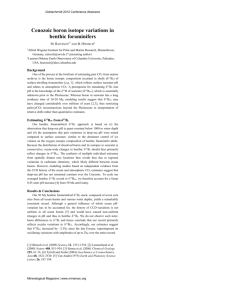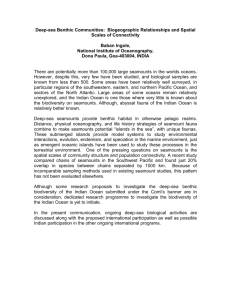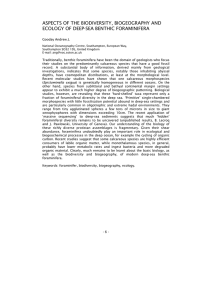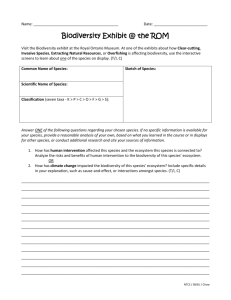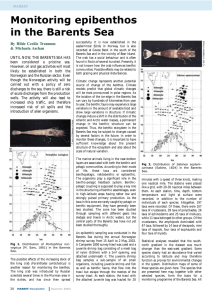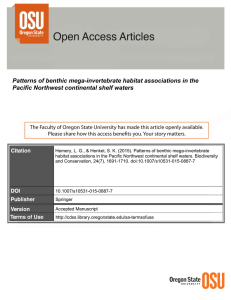Chairs : Pedro Martinez Arbizu; Andrew Gooday; Ana Colaco; Adrian... 15:00 15:15
advertisement
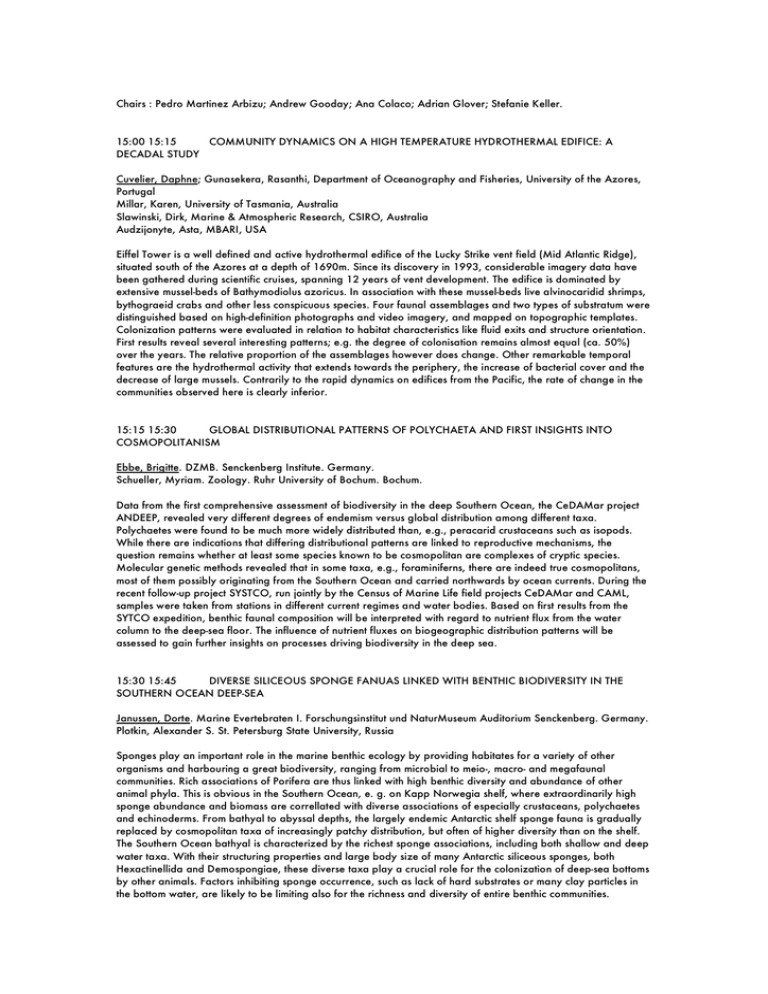
Chairs : Pedro Martinez Arbizu; Andrew Gooday; Ana Colaco; Adrian Glover; Stefanie Keller. 15:00 15:15 COMMUNITY DYNAMICS ON A HIGH TEMPERATURE HYDROTHERMAL EDIFICE: A DECADAL STUDY Cuvelier, Daphne; Gunasekera, Rasanthi, Department of Oceanography and Fisheries, University of the Azores, Portugal Millar, Karen, University of Tasmania, Australia Slawinski, Dirk, Marine & Atmospheric Research, CSIRO, Australia Audzijonyte, Asta, MBARI, USA Eiffel Tower is a well defined and active hydrothermal edifice of the Lucky Strike vent field (Mid Atlantic Ridge), situated south of the Azores at a depth of 1690m. Since its discovery in 1993, considerable imagery data have been gathered during scientific cruises, spanning 12 years of vent development. The edifice is dominated by extensive mussel-beds of Bathymodiolus azoricus. In association with these mussel-beds live alvinocaridid shrimps, bythograeid crabs and other less conspicuous species. Four faunal assemblages and two types of substratum were distinguished based on high-definition photographs and video imagery, and mapped on topographic templates. Colonization patterns were evaluated in relation to habitat characteristics like fluid exits and structure orientation. First results reveal several interesting patterns; e.g. the degree of colonisation remains almost equal (ca. 50%) over the years. The relative proportion of the assemblages however does change. Other remarkable temporal features are the hydrothermal activity that extends towards the periphery, the increase of bacterial cover and the decrease of large mussels. Contrarily to the rapid dynamics on edifices from the Pacific, the rate of change in the communities observed here is clearly inferior. 15:15 15:30 GLOBAL DISTRIBUTIONAL PATTERNS OF POLYCHAETA AND FIRST INSIGHTS INTO COSMOPOLITANISM Ebbe, Brigitte. DZMB. Senckenberg Institute. Germany. Schueller, Myriam. Zoology. Ruhr University of Bochum. Bochum. Data from the first comprehensive assessment of biodiversity in the deep Southern Ocean, the CeDAMar project ANDEEP, revealed very different degrees of endemism versus global distribution among different taxa. Polychaetes were found to be much more widely distributed than, e.g., peracarid crustaceans such as isopods. While there are indications that differing distributional patterns are linked to reproductive mechanisms, the question remains whether at least some species known to be cosmopolitan are complexes of cryptic species. Molecular genetic methods revealed that in some taxa, e.g., foraminiferns, there are indeed true cosmopolitans, most of them possibly originating from the Southern Ocean and carried northwards by ocean currents. During the recent follow-up project SYSTCO, run jointly by the Census of Marine Life field projects CeDAMar and CAML, samples were taken from stations in different current regimes and water bodies. Based on first results from the SYTCO expedition, benthic faunal composition will be interpreted with regard to nutrient flux from the water column to the deep-sea floor. The influence of nutrient fluxes on biogeographic distribution patterns will be assessed to gain further insights on processes driving biodiversity in the deep sea. 15:30 15:45 DIVERSE SILICEOUS SPONGE FANUAS LINKED WITH BENTHIC BIODIVERSITY IN THE SOUTHERN OCEAN DEEP-SEA Janussen, Dorte. Marine Evertebraten I. Forschungsinstitut und NaturMuseum Auditorium Senckenberg. Germany. Plotkin, Alexander S. St. Petersburg State University, Russia Sponges play an important role in the marine benthic ecology by providing habitates for a variety of other organisms and harbouring a great biodiversity, ranging from microbial to meio-, macro- and megafaunal communities. Rich associations of Porifera are thus linked with high benthic diversity and abundance of other animal phyla. This is obvious in the Southern Ocean, e. g. on Kapp Norwegia shelf, where extraordinarily high sponge abundance and biomass are correllated with diverse associations of especially crustaceans, polychaetes and echinoderms. From bathyal to abyssal depths, the largely endemic Antarctic shelf sponge fauna is gradually replaced by cosmopolitan taxa of increasingly patchy distribution, but often of higher diversity than on the shelf. The Southern Ocean bathyal is characterized by the richest sponge associations, including both shallow and deep water taxa. With their structuring properties and large body size of many Antarctic siliceous sponges, both Hexactinellida and Demospongiae, these diverse taxa play a crucial role for the colonization of deep-sea bottoms by other animals. Factors inhibiting sponge occurrence, such as lack of hard substrates or many clay particles in the bottom water, are likely to be limiting also for the richness and diversity of entire benthic communities.


